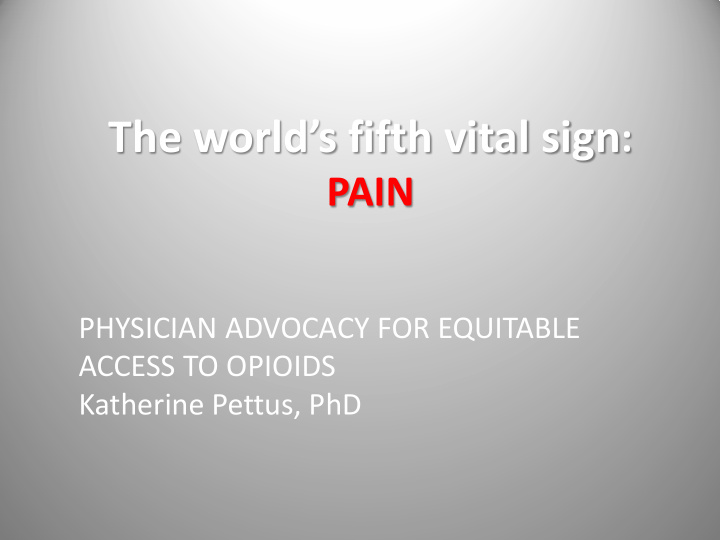



The world’s fifth vital sign : PAIN PHYSICIAN ADVOCACY FOR EQUITABLE ACCESS TO OPIOIDS Katherine Pettus, PhD
POLICY OF THE FIFTH VITAL SIGN Four fifths of the world is in pain because physicians in so many countries cannot access medical opioids
The culprit? TWO NARRATIVES International law: the Single Convention States Parties themselves on Narcotic Drugs They fail to remove barriers High funding for global drug “control” rather than provision Too many/outdated regulations Minimal funding for opioid provision Not enough trained health providers (NGOs) Inadequate health infrastructure Language of “evil” and “addiction” applied to drugs, consumers, Weak civil society traffickers Lack of institutional will “Fear of addiction” the main known barrier
Single Convention on Narcotic Drugs, 1961 Central aim to ensure provision of licitly cultivated, manufactured, traded, opioids Whose responsibility under international law to “secure adequate provision”? INCB (mathematical function of balancing supply and demand) Supply determined by aggregated demand Estimates system. No requirement of accurate assessment of need – Requires infrastructure and education of providers – RESOURCES - - “Parties shall supply estimates” – THAT IS ALL – NOW THERE ARE “INCB GUIDELINES”
CND and UNODC institutional priorities CND – Commission on Narcotic Drugs (governs UNODC) – represents nations UNODC – United Nations Office on Drugs and Crime – bureaucracy CND “THREE PILLARS” BASED ON 2009 Political Declaration to solve the “world drug problem” Demand Reduction Supply Reduction Combating Money Laundering We need to increase supply and increase demand for medical opioids!
7 UNODC FUNDING AND PRIORITY AREAS Countering transnational organized crime and illicit trafficking, including drug trafficking Countering Corruption Terrorism prevention and combating Justice Health and Livelihoods (combating drugs and HIV) Research and trends analysis Policy Support No subprogram or institutional commitment, staff, funding for EM: “central treaty obligation” What Happened??
HEALTH AND LIVELIHOODS “This Thematic Programme is based on the basic principle of all international conventions on action against narcotic drugs, psychotropic substances and transnational organized crime” BASIC PRINCIPLE IS ACTION AGAINST , NOT PROVISION “to prevent the flows and protect the health of individuals and societies from the dangerous effects of drugs , to address the health and social problems of drug users, drug dependent individuals and people living in prison settings, and to protect the populations vulnerable to HIV, human trafficking, organized crime and violence.
CND ACTION STEP: CALLS FOR CHANGE!! Refocus delegates on the conventions’ central objective: to ensure adequate provision of drugs for medical purposes Make provision of opioids for palliative care a UNODC sub-programme with dedicated staff and resources
THANK YOU FOR YOUR ATTENTION!
Recommend
More recommend